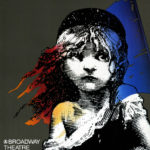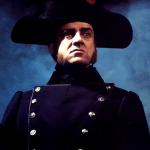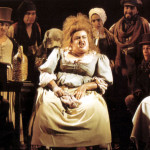As a longtime fan of the musical Les Misérables, sometimes I can hardly believe that a film version finally exists. After twenty-seven years of “maybe someday,” the musical phenomenon finally made its way to the big screen and is now available on DVD and Blu-Ray for all to see again and again. And the film’s influence has become apparent in the looks, details and atmospheres of many a subsequent stage production. It’s only natural for the cast and crew of any show, musical or otherwise, to want to consult the film version of said show as a professional model for their own work. Before the Les Mis film was made, actors frequently turned to the 10th and 25th Anniversary Concert DVDs for inspiration, and now that the show has an actual film version, its influence is strong.
I have mixed feelings about that fact. I love the film, I love nearly every performance in it and I’d gladly show it to anyone as an introduction to the musical. But I wouldn’t want any stage performers or director just to watch the film and copy it, without trying to make the show their own. The stage version of Les Misérables is nearly thirty years older than the film version, while Victor Hugo’s classic novel is more than a century older yet, and over the years the characters have been brought to life in interpretations very different from Tom Hooper and William Nicholson’s visions of them. Jean Valjean, Javert and co. certainly don’t need to resemble Hugh Jackman, Russell Crowe, et al for the musical to succeed. I’d even argue that several, if not all of the film’s main characters are distinctly different people than the characters whom fans of the stage version originally fell in love with.
This essay compares and contrasts the film characterizations of Les Misérables’s nine principles with different characterizations that are possible, and often more typically seen, onstage. My inspiration is the essay “Making Nice” on the now-defunct West Side Story website wssonstage.com. That essay explores the ways that the film version of West Side Story softens its main characters and makes them ore conventionally likeable than their stage counterparts: I notice a similar trend in the Les Mis film, though to a lesser extent. As with that author, my point isn’t to insult the film version or label its performances “wrong.” I just want to point out that the screen characterizations aren’t the be-all, end-all of how the characters can be played. Particularly not Javert, whose film incarnation is controversial among professional film critics and stage fans alike. Nor the four principle female roles, Fantine, Éponine, Cosette and Mme. Thénardier: all are given fairly delicate screen portrayals and the film has sometimes been accused of sexism, but onstage they can all be feistier or livelier and the show can feel very proto-feminist!
The alternate characterizations I describe sometimes draw on the novel, but not always. Some of the film characterizations are actually closer to Hugo’s. For the most part, they draw on the various stage performances I’ve seen of the musical, as well as the 10th and 25th Anniversary concerts (mainly the 10th because I’ve known it longer), and reviews I’ve read of countless other stage performances. In a way this essay is my tribute to all those stage performances, which the film, for all its magnificence and popularity, can’t eclipse in my mind.
Singing style
Before I discuss any character in depth, I’d like to discuss a detail that affects them all: the style of singing in the film vs. the style usually heard onstage. Let me start by saying that I fully approve of the film’s sound world, with its minimum of belting, its transpositions, its greater use of sing-talking, its emphasis on acting rather than vocal beauty, and its fast-and-loose playing with the score’s rhythms and markings to allow the actors maximum emotional spontaneity. These choices make the musical format mesh with the film’s gritty visual realism and help a cast of generally non-singing actors to give the most convincing performances they can. But when I say I approve of that sound world, I mean I approve of it in the film. Onstage I’d like the show to be sung as it always has been sung in the past: in a traditional theatre style, following the score as it’s written and the lead of a conductor, with rich and powerful voices.
Yes, Hugh Jackman is a triple threat who excels both in Hollywood and on Broadway, and among Hollywood’s elite there was probably no better choice for the role of Jean Valjean. Still, the role lies high for his baritone voice, and his loud, slightly strangled vocals in “Bring Him Home” are far from beautiful, even though his rendition is emotionally spot-on. Onstage the role is best served by a true tenor, equally capable of effortless, soaring power and of sweet, gentle falsetto. Even further from the traditional stage model is Russell Crowe’s Javert, with his subdued, soft-rock tones in a role that cries out for a powerhouse theatre-style baritone. Similarly popish is Amanda Seyfried’s Cosette. While her sweetly wispy vocals have a birdlike charm, the role is better served onstage by a full-blooded soprano: not operatic, per se, but a voice that could at least handle the role of Christine in The Phantom of the Opera, which many stage Cosettes have played.
And while Anne Hathaway’s raw, gasping, tear-drenched rendition of “I Dreamed a Dream” may have won her the Oscar she took home, I’d never encourage a stage Fantine to imitate that rendition rather than singing with the smooth, lush beauty of tradition. The stage version of the song comes at an earlier point and serves a different purpose. While in the film it captures the anguish of Fantine the broken-down prostitute, onstage it earns our sympathy for the lovely, respectable Fantine of the beginning of her character arc. Likewise, her death, and Éponine’s and Valjean’s, might be effective sung in feeble, struggling tones on film, but onstage I think the acting in those scenes should chiefly be body language. I would no more encourage those performers to compromise their singing quality by trying to sound sick or injured than I would an operatic soprano to try to sound realistically consumptive in La Traviata or La Bohéme!
I don’t mean to say that onstage, perfect singing should be emphasized at acting’s expense. Far from it! Several members of the original stage cast were Royal Shakespeare Company actors who had rarely, if ever sung onstage before, and not even the greatest singers in the show’s history have shied away from letting their voices go raw in moments of emotional agony. But the film’s “acting first” approach is extreme. As various Les Mis lovers less happy with the film than I am have pointed out, enormous emotion is innate within the music. No frayed or fragile tones or liberties with the score are needed to make it move an audience.
Now on to the characters…
Jean Valjean
I’m sure it’s easy for a Les Mis neophyte to assume that no portrayal of Jean Valjean can ever equal Hugh Jackman’s outstanding performance in the film. Say what you will about his singing, he puts his heart and soul into the role of the noble ex-convict and commands the screen with both subtlety and passion, giving what may very well be the greatest performance of his career. His Golden Globe win and Oscar nomination were both well deserved. But a role as rich as Jean Valjean, sometimes described as “the King Lear of musical theatre,” is arguably one that never has been and never can be performed definitively: not even by the magnificent Colm Wilkinson, who created the role and plays the Bishop onscreen. Every actor who takes on the part brings, or at least should bring unique qualities and dimensions to it. According to interviews, Colm Wilkinson expressly discouraged Jackman from imitating his legendary performance as preserved on the Original London and Broadway Cast Recordings and in the 10th Ann. Concert. I’m sure that Jackman would say the same to any future Valjean regarding his own performance in the film.
If Jackman’s Valjean has one weakness from a dramatic standpoint, it comes at the film’s beginning. While I can’t fault his almost frightening physical transformation into a scraggly, emaciated convict, or the air of brokenness, weariness and quiet bitterness he conveys, I doubt I’m alone in sometimes wishing he would express an even blacker hatred of the world. The whole point of Valjean’s story is that his years in prison transformed him into the vicious, hardened sinner he had unjustly been treated as, but that the Bishop’s kindness and mercy lead him back to God and virtue. While it’s true that even at his most ruthless he’s more sinned against than sinning, his journey is still one of redemption. But Jackman’s Valjean seems a bit less in need of redemption than he could have been, because the film portrays him throughout the Prologue as chiefly a victim. Apart from an understandable flash of rage toward the children who pelt him with stones, he never loses his temper. Nor does he do anything reproachable until he steals the Bishop’s silver, and even that shameful act, stripped of the monologue that precedes it onstage, feels impulsive, not cold-blooded. When others call him “a dangerous man,” it feels like yet another injustice being heaped onto him.
The stage version’s Prologue, on the other hand, not only allows but encourages Valjean to come across as a truly dangerous, frightening man, desperately in need of redemption. This version of Valjean responds to misfortune not with silent onward journeying, but with monologues of seething anger. His response to being turned out of the inn invites a delivery full of rage (“I’m not some kind of dog!”) rather than Jackman’s polite pleading, and in the standard staging, he goes on to physically attack a man in the crowd who treats him rudely. The theft of the silver feels more malevolent as well, as he feigns gratitude to the Bishop but privately dismisses him as an “old fool” and plots his crime. Then, when the Bishop responds to said crime with compassion, the emotional effect is explosive. Jackman plays with the music of “Valjean’s Soliloquy” and begins it slowly and softly as if in shock, but as written in the score, the opening passages are fast and neurotic. They cry out for Valjean to sing first with frantic confusion and horror as he realizes what he’s become, then with ferocious rage as he resists change, before lapsing into quiet reflection and finally into the agonized remorse and fiery determination to start a new life that Jackman so beautifully expresses in the film.
From here on, Valjean becomes a man whom anyone would admire, but still, it’s important that his actor avoid the pitfall of making him into a dull, one-dimensional saint. Ideally the convict of the beginning should never quite go away. John Caird, director of the original production, once summed up Valjean by saying “His struggle is the struggle of a potentially violent man to control the beast in himself and become good.” The most obvious places for him to convey this ongoing struggle are in the scenes with Javert – a willing actor can easily bring a sharper edge to those scenes than Jackman ever does. Try though our hero might to be civil and reason with his nemesis, it’s only natural that at certain moments, such as during “Confrontation,” his old feral rage should flare up with full blazing force. Once again, the stage text reinforces this characterization. The stage Valjean isn’t above threatening Javert’s life at Fantine’s deathbed and eventually escapes by knocking him unconscious, not by risking his own life leaping into the sea. Their exchange at the barricade is another chance for him to show his darker side, even while proving his nobility. The text doesn’t specify whether he asks to “take care” of Javert in order to free him or genuinely plans to kill him at first; some stage Valjeans actually raise the knife to his neck, but then give in to conscience and untie him. Even after that, some raise the knife again on “Clear out of here!” as if to say “…before I change my mind!” and then deliver “You are wrong and always have been wrong!” fuming with anger that Javert still sees him as a criminal.
Nor should any actor forget that Valjean’s journey to supreme selfless integrity is a gradual one. Throughout the story, he makes selfish mistakes that negatively affect others, and some of his most heroic deeds are his attempts to resolve those mistakes. As Monsieur Madeleine he plays the “benevolent boss,” but overlooks his workers’ individual needs and his foreman’s abuse of power, with Fantine paying the ultimate price. To atone for this, he adopts Cosette and gives her a loving home, but is overprotective and over-possessive of her until fate forces him to choose between her happiness and his own. How well he takes her objections to his behavior varies between actors as well. When she asks to know about his past, some Valjeans (like Jackman) refuse firmly yet gently; others are even gentler and more sympathetic to her pleas; still others refuse angrily, some even roughly grabbing her shoulders on “You will learn!”
But if the latter approach is taken, it needs to be handled with extreme care. The audience still needs to believe that Valjean is a good, loving father and that ultimately Cosette’s happiness matters more to him than his own life. To convey this, particularly without the aid of the film-only song “Suddenly,” a stage Valjean might want to infuse other moments with even more tenderness than Jackman does, and convey more remorse than Jackman does for the pain he knows his stifling protectiveness causes her. The classic staging of “One Day More” includes a beautiful father-daughter moment, not found onscreen, that reaffirms their love for each other despite their conflicting priorities: while packing for their journey, Valjean finds Cosette’s old doll and hands it to her, and they silently remember the night he gave it to her, then share a warm embrace.
Bringing a darker, fiercer side to Valjean than the film does will in no way detract from his heroism. Just as long as he constantly balances those darker moments with proof of his inner goodness: tender affection toward Cosette and desolation at losing her, tender compassion toward Fantine and grief at her death, earnest and passionate prayer for Marius’s life in “Bring Him Home” despite the fact that Marius’s survival will destroy his own happiness, monumental efforts to atone for all his mistakes, a sense of ever-growing compassion for all humankind, and a sense of strength and integrity in the face of every obstacle. These noble qualities will make any audience love him and invest in his life’s journey, from its fearsome beginning to its gentle end. Combining them with a handful of grittier traits will only make him a richer, more complex figure.
I don’t mean to imply that Hugh Jackman’s performance is bland, whitewashed or inadequate in any way. I adore his Valjean and, with all due respect to Daniel Day-Lewis and Lincoln, I only wish that his work were acknowledged with an Oscar win, not just a nomination. But as I said before, the role of Valjean is one that every actor should try to infuse with new qualities, not just copy others. A slightly darker and grittier portrayal is just the most obvious, text-supported alternative to Jackman’s screen characterization. I only hope that these paragraphs inspire some actor to explore the role even more deeply than I have and create his own, unique vision of Victor Hugo’s magnificent character.
Javert
Whether you love or hate Russell Crowe’s Javert, and there are definitely people in both camps, everyone can agree that his portrayal of the dogged inspector is like none that came before him. The film reinvents the character almost completely, with very controversial results. From beginning to end, while he remains rigid, stern and dedicated to the law at nearly all costs, Crowe’s Javert is “humanized”: less a merciless persecutor of all rebellion against authority than just a good policeman doing his job. The responses of longtime Les Mis lovers have ranged from “He makes me feel for Javert like no one has before” to “Completely bland and insipid – the character may as well have been cut.”
Devoted though the screen Javert is to the law, his devotion isn’t so single-minded as to exclude reason or compassion. While predictably merciless when arresting Fantine, he only briefly protests when “Monsieur Madeleine” appears and demands she be freed, and even stops a constable from intervening when she spits at Valjean, seemingly wanting to hear her out or at least let the mayor deal with the insult himself. In his confession scene in the mayor’s office, not found onstage, he’s shown to be quick to admit his mistakes and just as hard on himself as he is on criminals when he thinks he’s done wrong. His ode to his belief system, “Stars,” isn’t a powerhouse declaration of unshakable principles, but a quiet moment that can easily be interpreted as one of insecurity – a subtly desperate effort to convince himself that his “way of the Lord” will prevail, despite Valjean’s eluding him again and again. Most memorably of all, he’s shown to be appalled by the slaughter of the young revolutionaries, especially the death of Gavroche, to the point that he takes off his own Legion d’Honneur medal and places it on the brave boy’s lifeless body. We sense that his horror and shame that “the law” sanctioned this atrocity shatters his law-worshiping worldview and drives him to suicide just as much as Valjean’s mercy does, even though his final soliloquy only mentions Valjean.
With all this “humanization,” we might expect his suicide aria to overflow with emotion, but surprisingly, such isn’t the case. Both “Stars” and “Javert’s Suicide” are delivered in an acting style that’s distinctly “film”; unlike musical-veteran Hugh Jackman, who emotes in his solos the way any stage actor would, Crowe limits his expression to what a stoic man like Javert would actually convey while immersed in private thoughts. The anguish is there, but expressed mainly through his eyes. Yet given that he hasn’t been stonehearted throughout, but already shown us a compassionate, vulnerable side, he arguably doesn’t need a spectacular emotional breakdown to make viewers feel for him.
This is far from the usual characterization of the man who has been called the most fearsome detective in all of literature, who inspired the figure of the relentless Lt. Gerard in The Fugitive (note the similar sound of their names), and whose very name has become synonymous with inexorable, unjust persecution. For the performance widely considered the ideal embodiment of the stage Javert, look to Philip Quast in the 10th Ann. Concert. With his imposing figure, rigidly dignified posture and rich, steel-edged baritone that commands instant attention, this Javert is a glacier of a man who never flinches in his hard, fierce devotion to justice or in his disgust at all transgression against the law. From Toulon through Montreuil to Paris, he never once believes himself to be wrong until his whole world is derailed by Valjean’s mercy at the barricade.
This type of Javert repeatedly and vigorously protests “the mayor’s” resolve to free Fantine. When she spits on Valjean, he’s usually the one who moves to grab her, only for Valjean to motion him back. Later, he wastes no grief or pity on the massacred revolutionaries; they were traitors who threatened the social order and their deaths were necessary. A traditional stage Javert’s only concern when he comes back to the barricade is finding Valjean. Yet despite all this ruthlessness, he still needs not seem like a villain. How moving it is in the 10th Ann. Concert when, during his iconic solo, Philip Quast tremblingly half-whispers “Stars…” and removes his hat in humble veneration for the natural phenomenon that seems to prove the orderly, law-driven nature of God’s universe! At that moment we see the human heart that beats under his uniform and know that his actions don’t stem from cruelty, but from deep, sincere belief that his way “is the way of the Lord.” A belief which he then proclaims with staunch, fierce passion on “And so it must BE!” making it clear that his mind has no room for doubt and that he will indeed never rest as long as Valjean or any other lawbreaker runs free.
The more rigid and resolute Javert is throughout, the more dramatic it is when his convictions ultimately fall apart, and in a typical stage performance he completely, heartrendingly falls apart along with them. Like “Valjean’s Soliloquy,” its musical twin, “Javert’s Suicide” is traditionally explosive. The inspector’s stoicism vanishes and we see desperate confusion, rage, anguish and terror as he faces a world where nothing is certain anymore. His final dissonant cry of “There is no way to go OOOOON!” becomes not just the last note of a song, or just an aural signal of his leap from the bridge, but a roar of agony.
Of all the characters in the film, Russell Crowe’s Javert is probably the most different from the character known and loved by longtime fans of the stage version. His inspector is gray, with clear human feeming and vulnerability even in his sternness and with stoicism even in his despair. A typical stage Javert, stony, sinister and unyielding until his earth-shattering psychological breakdown, is almost as black-and-white as his worldview. I won’t label one characterization better than the other; if I did, either way, hundreds of other people would disagree with me. But I will say this: the character of Javert doesn’t need to be “humanized” to be a gripping, moving presence. In a great singing actor’s hands, a traditionally stolid, fearsome inspector can in his own way be just as human, just as complex, and in his ultimate crumbling, every bit as sympathetic as the character in the film.
Fantine
While Hugh Jackman is unquestionably the star of the film, the most iconic performance, the one that first come’s to most people’s minds whenever the film is mentioned, is almost certainly Anne Hathaway’s heartbreaking turn as Fantine. This is due partly to the status of “I Dreamed a Dream” as a popular hit and its resulting heavy use in the film’s advertising, but there’s no question that the raw passion, fragility and sincerity of Hathaway’s award-winning performance (Oscar, Golden Globe, BATFA, Critics Choice, Screen Actors Guild, and more) has an impact that extends far beyond her short screen time. Yet like most acting performances, even the great ones, hers has had the occasional detractor. Amid the endless praise and slew of awards, some isolated cries of “overacting” and “too fragile” have been heard now and then. Potential stage Fantines, take note! Even when a performance takes Hollywood by storm and seems definitive, not everyone is satisfied, which means there are different ways that the role can be approached.
While she certainly doesn’t lack fighting spirit, Hathaway’s Fantine is still a distinctly vulnerable Fantine, who wears her heart on her sleeve and cries more tears within fifteen minutes than most film actresses probably do in two hours. Unsurprisingly, feminist critics have been divided between appreciating the strength and scrappiness she conveys and complaining about her “passivity.” How, you might ask, can a stage Fantine bring strength to the role that’s clearer to everyone, yet still be vulnerable enough to be moving? One time-tested option is to play her with an aristocratic air, as opposed to Hathaway’s working-class everywoman characterization: to highlight the fact that despite her impoverished birth, she briefly knew a more sophisticated life with Cosette’s wealthy father, and to derive an air of quiet strength from her stateliness. Ruthie Henshall in the 10th Ann. Concert embodies this characterization, with her bell-like voice, posh accent, puffy-sleeved dress, immaculate blonde hair and, in the words of Hugo’s own description of Fantine, “serious and almost austere dignity” that sometimes resembles “the disdain of a goddess.” She stands out as a true lady among the coarse-edged factory women, and later among the whores, and its clear even before “I Dreamed a Dream” that her former life was a better one. It’s no wonder that the other workers should scorn her for “putting on airs” and thus believe the worst of her too easily. But as we, the audience, learn her past and see into her heart, we feel deeply for her as the dignity she so clearly values is stripped away.
Such a Fantine would rarely cry, even as her heart breaks. In the factory scene, she would fearfully yet decisively reject the foreman’s advances rather than meekly trying to evade them. When her secret is revealed, while still conveying horror and desperation, she would stay composed and try to reason with her oppressors in a dignified way, as opposed to Hathaway’s tears and frantic pleas. And throughout “Lovely Ladies” she would struggle with all her might to keep her pride, but in the end willingly give it away for Cosette’s sake, because the one thing she values more than her pride is her daughter.
The most obvious time for a stage Fantine to convey a core of steel, however, is after her turn to prostitution. The restructuring of that portion in the film, with “Come on, captain…” sung tentatively to her first customer before they bed down, and the desolate “I Dreamed a Dream” coming afterwards instead of long before, effectively guarantees a more vulnerable take on her fall from grace. But a stage actress can vividly convey a hardening and bitterness toward the world that Hathaway only implies through subtle facial expressions. The stage version of “Come on, captain…” can be delivered in multiple ways: Ruthie Henshall clings to her ladylike dignity even as she plays the seductress, while other Fantines transform over the course of “Lovely Ladies” and in the end become just as brash, drunk and lower-class as the other whores. But either way, a stage Fantine can imply that weeks have passed in the fraction of a minute she’s been offstage, that she’s now all too used to her repulsive profession, and to quote Hugo, that “in turning to mud she has turned to stone.” At the end of the passage, when she howls “Don’t they know they’re making love to one already dead?!” in scathing rage, we might even be reminded of Valjean’s ferocity in the Prologue. Of course Hathaway’s Fantine also very purposefully evokes him, with her similarly shorn head, ragged red costume, and even a few parallel screen shots, but onstage her sheer bitterness can be a match for his too, making us feel that only her love for Cosette keeps her from becoming just as vicious as he was.
This anger and hardness can carry over dramatically to “Fantine’s Arrest.” Instead of taking Hathaway’s approach to the Bamatabois scene (obviously sick, exhausted, possibly drunk, disoriented when she rejects his advances, and then clawing at his face in impulsive animal rage), a stage Fantine can stoically approach him, fully in control of herself and ready to take him as a customer, but then decisively pull away when he turns aggressive. Her clawing at his face, in response to a beating and possible near-rape rather than snow down her dress, can be an equally decisive display of ferocious defiance. (“Even a whore who has gone to the bad won’t be had by a rat!”) Nor would such a Fantine have any shortage of venom for “Monsieur Madeleine” when she informs him of his unwitting part in her plight. Her anguished pleas to Javert in the same scene, her tenderness whenever she speaks of Cosette, her slow and painful decline in health, and of course her heartrending delirious death will ensure that even with additional toughness, she still draws tears from the audience.
While a Fantine with no vulnerability would hardly be effective, a Fantine with no strength or fierceness would be no better. For this all-important character to move a modern audience, she needs to be more than just “the pathetic self-sacrificing mother.” Anne Hathaway’s gripping film performance beautifully combines sadness, tenderness and fragility with flickering flames of strength and anger, but still, its pitch is clearly toward the fragile side. A less flickering, more consistently burning flame of courage, dignity and defiance is a good way for a stage actress to make the role her own, to make her Fantine feel fully human and not like a sentimental stereotype of motherhood or victimhood, and to ensure that she earns not just pity, but admiration.
The Thénardiers
The roles of the Thénardiers in the film are distinctly tailored to the talents of the actor and actress who play them. This is probably true for most comic roles when new comedians take them on, particularly famous comedians. As played by Sacha Baron Cohen and Helena Bonham Carter, the nefarious couple bears only a semi-resemblance to the pair whom stage audiences have loved to hate since 1985 and whom novel readers have hated since 1862. This isn’t necessarily a bad thing – the film Thénardiers are a bit less caricatured and arguably a shade more realistic, yet still funny. But all the same, it’s a fact worth addressing.
Both screen Thénardiers are textbook cases of “adaptational attractiveness.” Hugo’s Thénardier is a small, scrawny, sickly-looking, middle-aged man, while his massive brute of a wife is labeled a “mastodon” and a “market porter in petticoats.” Not all stage performers fit those exact descriptions, but still, they virtually never sport the comparative polish and conventional good looks of Cohen and Carter. This is evident from once glance at Alun Armstrong, Matt Lucas, and the “wife” they share, Jenny Galloway, in the two anniversary concerts! Regardless of a stage Thénardier’s height, build or age, he typically sports scraggly hair, a 5 o’clock shadow and bad teeth. Nor does the “classy” French accent that Cohen adopts whenever he wants to seem sophisticated have any basis onstage – your average Thénardier makes no attempt to hide his working-class accent, whether that accent is Cockney, standard American, or anything else. And even if Mme. Thénardier isn’t large or masculine looking, she’s virtually always a comically hideous frump. Certainly not the type who could ever have played Ophelia in Hamlet, or who would have much success, let alone specialize in seducing men to pick their pockets the way Carter does in the film!
Not only is the average pair of stage Thénardiers more grotesque in looks than their film counterparts, but in personality too. While of course every Thénardier brings his own comic style to the role, Cohen’s dry brand of humor with its sotto voce adlibs and slick subtlety is far from typical for the stage. In a 14,000-seat theatre it would probably be too subtle to fully “register.” Much more common are performances like Armstrong’s and Lucas’s in the concerts: brash and broadly comic, with a clear sense that Thénardier relishes every moment of his dirty deeds. Likewise, his wife isn’t usually subtle or deadpan in the least, but loud, brazen and bawdy, with a monstrous temper. A typical result of this additional brashness is more “gross-out humor” than we see onscreen. Your average stage Thénardier may not pee into a wine bottle or chop off a cat’s tail as a sausage ingredient, but he does typically add his own nose-pickings to the grinder, wash cups with his own saliva, and lift his leg on the trombone slide that leads into “Master of the House” as if he were letting out a long, loud fart. His wife tends to do similar things too, such as gulping wine directly from the jug before taking it out to the customers, or sneezing on a couple just as she serves them their food, and she typically does a vulgar gesture with a spoon or a rag-corner on “…there’s not much there.”
But however broad their humor is, it’s important to beware of too much hamming and especially of playing the roles exclusively for laughs. The audience shouldn’t forget that these are the two most evil characters in the whole story; perfect examples both of the kind of corruption that poverty and hardship can spawn, which Valjean could have fallen into if not for the Bishop’s compassion, and of the greed and selfishness of the upper classes they ultimately join. Leo Burmester, the original Broadway Thénardier, once aptly described the character as “the kind of guy who will show you a great time… but when the chips are down, he’ll kill you as soon as look at you.” One of the most widespread criticisms of the film Thénardiers from Hugophiles is that they lack the ideal sinister edge.
However, there are plenty of ways for a stage actor and actress to come across as more sinister than their stage counterparts. A good place for them to start is with the treatment of Young Cosette. Where Carter sneers at her in casual disdain, a typical stage Mme. Thénardier bellows at her in rage as if it were here fault that Fantine sends so little money, accompanied by rough arm-grabbing, shoving, and an obvious implication that she beats her. (Onstage, Young Cosette usually sports a black eye and several bruises, which the filmmakers opted not to give her.) Later, at the beginning of “The Bargain,” Thénardier might angrily growl “Where the hell have you been?!” at the little girl before noticing Valjean beside her. A further source of potential darkness is the couple’s treatment of their own daughter. The filmmakers’ choice to portray Thénardier as a loving father to Young Éponine is just that; a choice. Stage actors often completely ignore her in favor of the inn’s customers, and or even snarl at her to “Get outa here!” upon entering. And many a stage Thénardier subjects the grown-up Éponine to startling levels of abuse during “Attack on Rue Plumet,” not just slapping her, but knocking her to the ground, grabbing her by the hair, or even threatening her with a knife. Likewise, the stage version of “The Robbery” implies that his wife’s days as a doting mother are finished and that Éponine now bears the brunt of her temper as Cosette once did. (“She never had a scrap of brain!”)
However, the strongest vehicle for Thénardier’s sinister side is in his solo in the sewers, “Dog Eats Dog,” the one song in the score to be cut from the film. While it’s unnerving to see Thénardier robbing corpses whether he sings as he does it or not, it’s especially unnerving to hear him gloating over each trinket and cracking jokes all the while. Then, when he declares “It’s a world where the dogs eat the dogs…” we leave any trace of comedy behind and see the character exactly for who he is, a man who is evil because he hates the world. In my experience, there are two ways that an actor can sing the last verse: either grinning at the audience in sneering contempt for their morals and religious faith, or with vicious, defiant rage, fully displaying the “deep furnace of hatred” that Hugo tells us Thénardier has burning inside him. But either way, the effect is chilling.
Last but not least, every pair of Thénardiers needs to work well as a team and find their own, unique brand of chemistry that best suits their individual characterizations and comedy styles. The libretto reveals little about the couple’s relationship and blindly copying Cohen and Carter’s rapport would be a cop-out. While the film’s portrayal of Thénardier as a henpecked husband and his wife as the true “master of the house” is funny (if slightly clichéd for a comic couple) and can work well onstage too, it’s just as easy to portray the pair as fully equal partners in crime, or to be truer to the novel and play the husband as “the brains of the outfit” and the wife as his put-upon, resentful sidekick. And the film’s conceit that the Thénardiers are truly a happily married couple, despite Mme. Thénardier’s complaining, is just that, a conceit. It’s equally valid to play them as genuinely despising each other, only staying together because it’s useful to have a competent criminal spouse, and to derive comedy from their endless bickering.
Unlike some Les Mis fans, I wouldn’t change a thing about either Cohen’s performance or Carter’s, except to reinstate “Dog Eats Dog.” It’s probably always best to tailor comic roles (or any roles) to the performers’ specific talents rather than force them to play awkwardly against type. But the fact remains that, whether we like it or not, they’re as atypical a pair of Thénardiers as the libretto allows. The house is the same, but the master and mistress are different.
















michele
December 28th, 2013 at 04:28
this is not merely a review, critique, comparison…this is a book. Get this published!!! It’s unbelievably detailed. Wow…
Jennifer
April 13th, 2014 at 12:40
What you said about Cohen and Carter’s attractiveness got me to thinking about the 2000 French/English co-production with Gerard Depardieu (which wasn’t perfect, but had its moments). I remember being surprised at the attractiveness of the Thenardiers; he actually looked pleasant and agreeable, the picture of an honest businessman, and she was actually PRETTY. For someone that was so used to the filthy, sleazy couple from the show, this came as a shock…until I realized that unlike the stage version, we actually saw the scene where Fantine left Cosette to stay at the inn. Then I realized that if the Thenardiers hadn’t given at least the impression of a pleasant, reliable couple, Fantine would never have trusted them with her daughter in the first case!
It is a shame that they cut “Dog Eat Dog”, since the creators intended that as one of the three important song that express religious belief. “Bring Him Home” was from someone who believes in a loving, forgiving God, “Stars” was from someone who believes in a very Old Testament God, and “Dog Eat Dog” was from someone who believes God is dead. (It’s a nice touch that Thenardier sings “…dead as the stiffs at my feet…”, yet Marius ISN’T dead!)
I always liked the fact that the verses of “Dog Eat Dog” were a dissonant variation on the “Master Of The House” melody, as if to say, “Playtime’s over. This is the REAL face of the guy you were laughing at an act ago…this predator crawling around in the mud.” Many productions I’ve seen have Thenardier actually howling that last note like an animal.